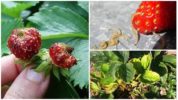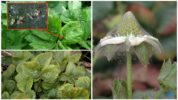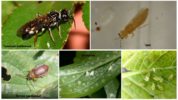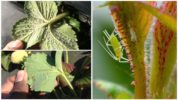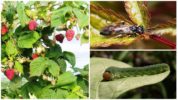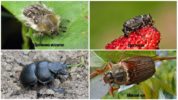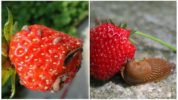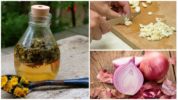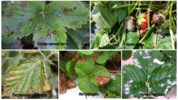- Nematodes
- Strawberry mite
- Spider mite
- Strawberry Leaf Pests
- Strawberry leaf beetle
- Aphid
- Thrips
- Strawberry sawflies
- Whitefly
- Strawberry Beetles
- Shaggy bronze
- Weevils
- Strigun beetle
- Chafer
- Strawberry Slugs
- How to process strawberries from pests - folk recipes
- Strawberry disease
- White spotting
- Brown spotting
- Gray rot
- Late blight
- Leaf rust
- Powdery mildew
- Verticillus wilting
- Prevention of pests and diseases
- Strawberry Nematodes
- Strawberry tick and spider mite
- Strawberry pests
- Aphids on strawberries
- Strawberry sawfly
- Beetles on a Strawberry
- Strawberry Slugs
- Folk recipes for pest control
- Strawberry disease
Strawberries can not be called unpretentious culture. The amount of harvest depends on the quality of the seed, soil composition, climatic conditions, the selected site, following the rules of agricultural technology. However, it is worthwhile to allow small oversights in the care, as berry bushes affect various diseases that can completely destroy the plantations. No less harm is caused by strawberry pests. A detailed review and description of the culprits in reducing the yield and death of bushes will help in time to take the necessary measures to save strawberries.
Nematodes
Strawberry leaf nematode occupies a central place on the "board of honor" of diseases and pests of strawberries. Nematode infection is called nematodosis. Parasites are ubiquitous. They are thin white, yellowish worms, the length of the individual does not exceed 0.7-0.8 mm. The eggs of the nematodes are white, oblong, but it is impossible to examine them without optical devices. A photo of strawberry pests is presented below.
Signs of parasitization of a stem strawberry nematode:
- the appearance of brown, red spots;
- thickening of leaf veins;
- stunted growth, bushes become dwarf;
- thickening of the aerial parts;
- leaves become leathery, wrinkled, without pubescence;
- rosettes are deformed, small berries.
Important!
Strawberry infection occurs when planting infected seedlings. Nematode eggs do not lose viability for several years, they are resistant to low temperatures and it happens that the bushes are planted in the soil in which the parasites settled. The possibility of transferring worms or their eggs to an instrument, shoes from another site is not excluded.
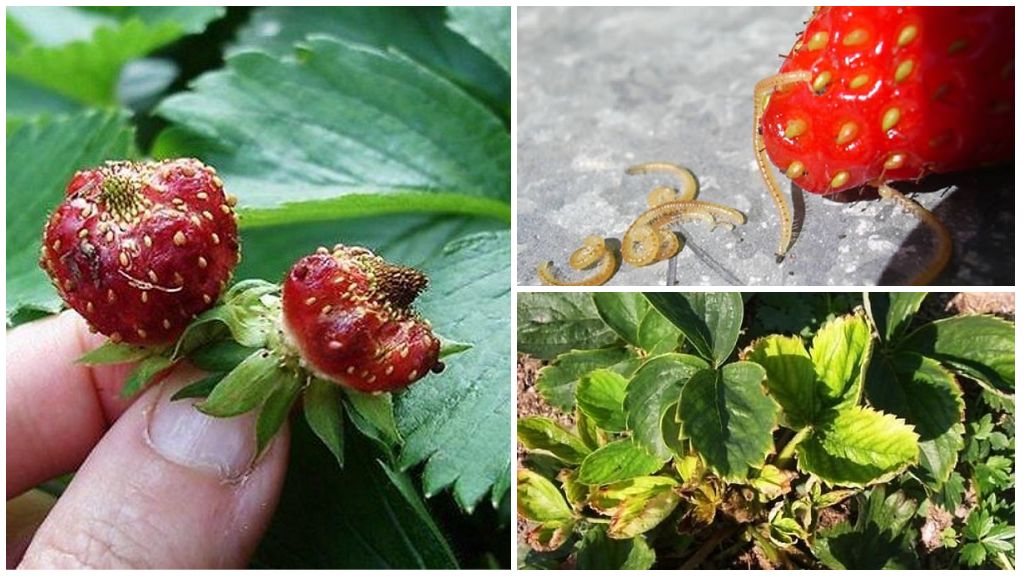
It is difficult and not always possible to get rid of pests:
- In the event of a large-scale defeat, the damaged bushes are eliminated, and on this site they stop growing strawberries for 5-7 years.
- At the end of the season and early spring, the bushes should be treated with a 3% solution of vitriol.
- Fitoverm, Fundazol, Skor, Lindan, Mercaptofors will help reduce the population.
- Folk remedy based on a pharmaceutical drug. Dissolve 5 Decaris tablets in room temperature water (5 L) and water the resulting solution. To get rid of nematodes, the procedure is repeated three times.
- Pour strawberry from pests with concentrated nettle infusion.
Preventive measures include the acquisition of quality material, it is recommended to treat the roots with hot water (50 ° C) before planting. Transplant strawberries every 3-4 years. Disinfect work equipment. Along the perimeter of the plantation with berry bushes plant a calendula.
Strawberry mite
The generalized name of two species: transparent and cyclamen. Due to its microscopic size, it will not be possible to see and recognize whitish pests on strawberries. Pests begin to show activity in March, when the air warms up to 13 ° C. They like high humidity, they are afraid of direct sunlight. First, they absorb nutrients from leaf tissue, and later move to color buds.
On a note!
Parasitization of strawberry ticks leads to a violation of photosynthesis, potassium deficiency. Leaf plates look oily, wrinkled. Due to the lack of nutrient components, the berries are formed small, often dry prematurely. In affected bushes, resistance decreases, which is why they freeze in the winter.
Even before the growth of green mass begins, the plants are treated with colloidal sulfur or Karbofos. During the growing season, strawberries can be sprayed from pests with dandelion, garlic or onion husk infusion. With a massive invasion of strawberry ticks, Fitoverm, Fufanon, Actellik are used. To stimulate growth and increase resistance to pests, fertilizers Azotofit, Biohelat are introduced into the soil.
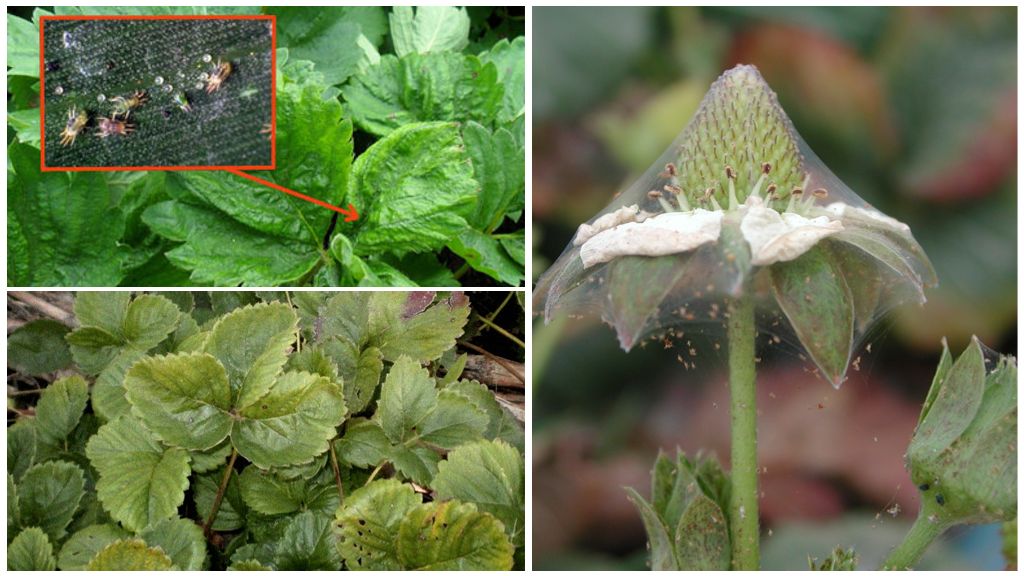
Spider mite
Another representative of arachnids. Like previous copies, it can not boast of large dimensions. In the family spider mites described about 1200 species. All of them are herbivorous, similar in appearance and damage.
- The length of individuals does not exceed 0.8 mm.
- The tiny ellipsoid body is covered with bristles.
- The imago has 8 legs, the larvae have 6.
- Color depends on age and gender. The younger generation in green, brown tones. Females of the last generations preparing for wintering, saturated red tones, brown. Therefore, if microscopic red bugs on strawberries were found in August-September, it is likely that the bushes were occupied by spider mites.
Important!
On average, the development of one generation takes 8 days. Each individual is able to lay up to 150 eggs. From 8 to 12 generations are possible in a year, depending on climatic conditions. The population reaches the greatest numbers in August.
How to identify a spider mite on strawberries:
- the appearance of white dots on the underside of the leaves is a sign of tick punctures;
- subsequently they are converted into yellow spots, eventually merging into a single whole;
- premature falling of leaves;
- dwarf shrubs;
- dry small berries;
- the appearance of the web.
Important!
In case of ascertaining the fact of parasitization of the tick, the processing of strawberries from pests is carried out at least three times. This is due to the dense shell of the eggs, which no insecticide can destroy. In hot weather at a temperature of 30 ° C, spraying is carried out every 3 days. At a temperature of 20 ° C, the interval between treatments is 5 days.
How to treat strawberries from pests:
- For the preservation of bushes and the extermination of ticks, the drugs Actellik, Aktofit, Apollo, Fitoverm, Karbofos, Vertimek, Antikleshch, Kleschevit, Karate, Flumayt are used.
- At the first sign of damage, the bushes are treated with soapy water.
- Folk remedies: infusion of dandelions, onion husks, garlic, calendula, tomato tops, soap-alcohol solution. Detailed recipes are presented below.
Strawberry Leaf Pests
Green mass attracts leaf beetles, thrips, aphids, whiteflies, strawberry sawflies.
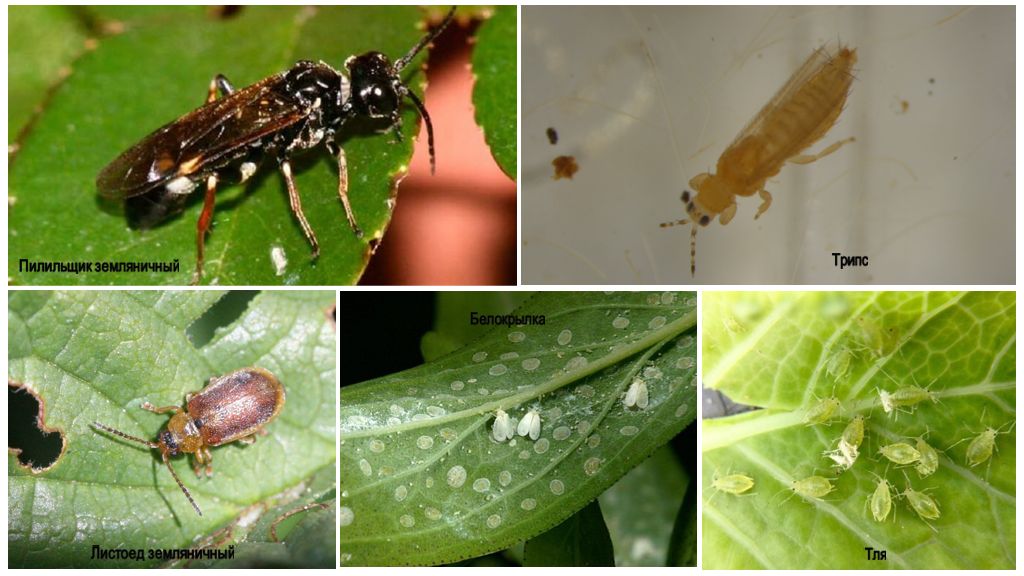
Strawberry leaf beetle
Red bugs on strawberries may turn out to be leaf beetles. The color of individuals is diverse: dirty yellow, brown, red shades. Sizes 3-4 mm. Larvae yellow, up to 5 mm long; on the body there are rare bristles. A massive invasion of leaf beetles is noted during the appearance of flower brushes. Females gnaw a hole in the leaf plates and lay pinkish eggs. Hatched larvae immediately begin to parasitize and actively feed on leaves.Having accumulated a sufficient amount of nutrients, they go to the topsoil for pupation.
The appearance of young beetles coincides with the completion of fruiting. Autumn strawberry pests continue to feed on green mass, but not as intensively as in spring.
On a note!
Strawberry bugs make a large number of holes in leaf blades at the edges or in the center. But they can also eat out the pulp, making winding passages in it and not affecting the skin.
Attacks of leaf beetles can completely deprive the bush of green mass. Loosening the soil in summer is of great importance in the destruction of pests, since the pupae are at a depth of no more than 3 cm.With a small number of beetles, wood ash, tobacco dust are scattered in the rows, and strawberries are treated with dandelion, calendula, wormwood, soap solution.
If there are more than 4 leaf beetles on the bush, it is necessary to deal with the red bugs with store-bought products: Corsair, Actellik, Wofatox.
Aphid
Small insects of yellow green, black color with wings and without are familiar to many gardeners without descriptions. Live aphids colonies multiply rapidly. Photos of strawberry pests clearly show how numerous aphid groups are. Are under the protection of ants who love their sweet secretions - span. The same sticky mass becomes a source of soot fungus.
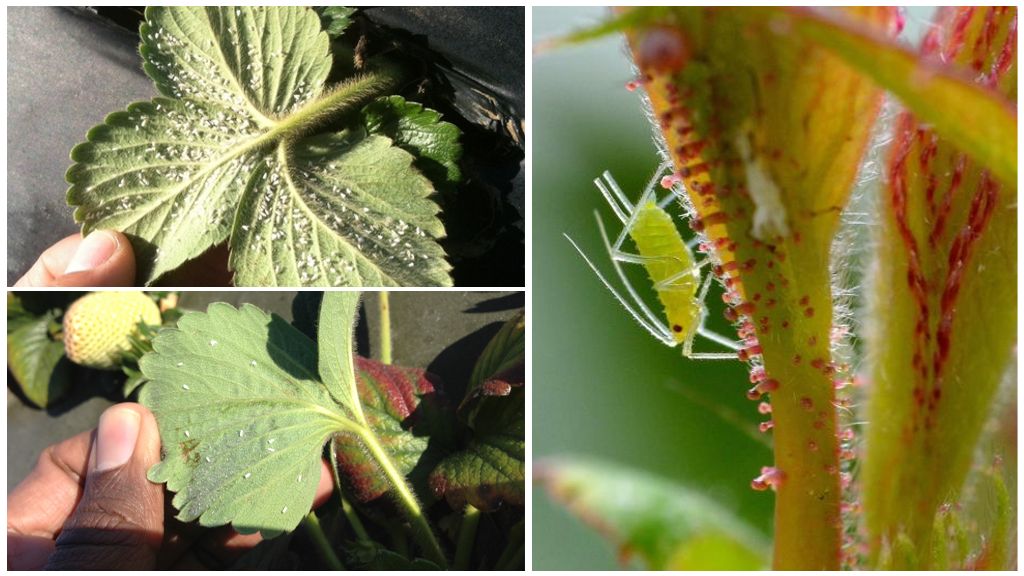
Signs of defeat:
- crawling insects are visible on the back of the leaves with the naked eye;
- whitish, sticky plaque on leaf blades;
- yellowing and premature fall of the green mass;
- scurrying ants.
What to do if aphids appeared on strawberries:
- Remove heavily affected plants.
- Rinse the leaves, paying particular attention to the inside, with a soapy solution.
- To achieve a quick result, pest agents are used: Actellik, Aktara, Fitoverm, Spark, Fas, Lightning, Karbofos, Arrow, Inta-vir.
- Fight aphids can be folk remedies: infusions of herbs, strongly smelling plants, soda, vinegar, tobacco.
On a note!
When trying to get rid of aphids, do not forget about their allies - ants. The struggle with small workers can be humane and consists in digging up the anthill and moving it to a place remote from the site. Advocates of more drastic measures for extermination of ants in the area apply Ant, Anteater, gels, folk remedies.
Thrips
Insects of gray, yellow, black color with an elongated narrow body, the length of which is no more than 1 mm. Narrow wings on the sides. Frisky insects prefer to live collectively. Females lay hundreds of eggs at the feeding facility. Embryonic development lasts 5 days and gluttonous yellow larvae appear.
Symptoms of parasitization of thrips:
- yellow or discolored spots on the leaf plates, which gradually merge into one;
- silvery fragments on the ovaries indicate mass settlement;
- deformation of berries - a bifurcated peak, with the formation of "horns".
To control pests, strawberries use chemicals, but only before budding: Zolon, AlatarKarate. During the formation of ovaries, the use of biological products is allowed. In almost all phases of the growing season, you can process strawberries from thrips with folk remedies based on herbs and tobacco.
On a note!
It was noticed that if you add 30 g of fructose per 10 l of working solution for processing strawberries, the effectiveness of the procedure is significantly increased. Fructose acts as a bait and the number of dead pests increases.
Strawberry sawflies
He is a rose sawfly. A black shiny insect 1 cm in size with transparent wings and a short thick antennae on the head, for which it is commonly used as a fattening. The years of the first generation coincide with the beginning of flowering strawberries. The female makes cuts in the leaves and lays eggs.After 5-12 days a larva emerges from it - a false caterpillar, the body of which is covered with warts, and black spots are noticeable along the body. The offspring are very voracious, able to leave the bush without foliage.
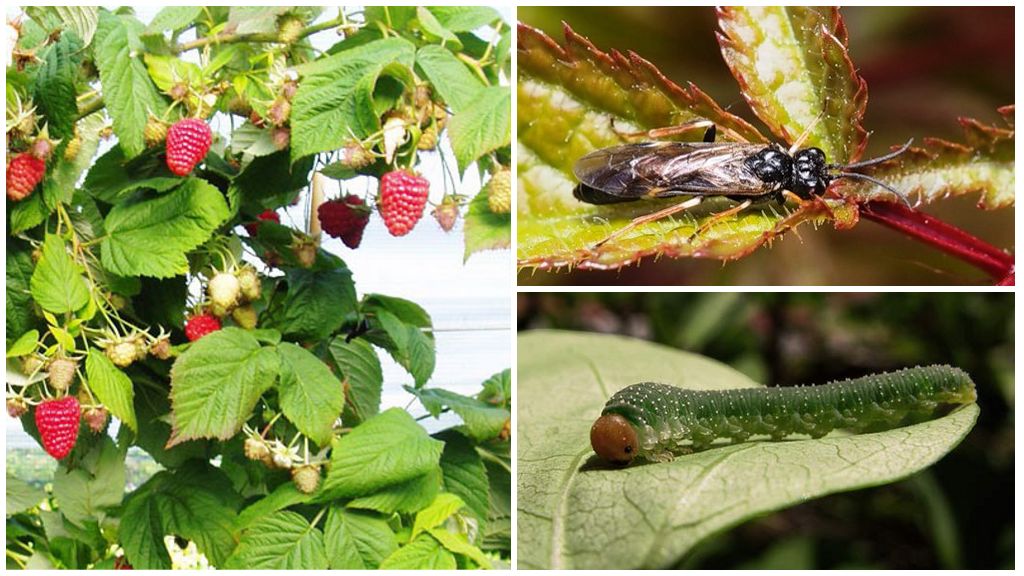
Signs of defeat:
- brown notches at the oviposition sites;
- skeletonization of a sheet plate, patterns;
- if you disturb the larva of the sawfly, it folds into a ring.
To kill larvae sawflies they use drugs from strawberry pests: Aliot, Novaktion, Bitoksibacillin, Actellik, Inta-virus. From folk remedies use a decoction of wormwood.
Whitefly
Due to the tiny size of these pests, they are often called white midges. Sizes 1-1.5 mm. Yellow body with snow-white wings. Grouped on the bottom of the sheet. More than 1,500 species are known.
How to understand that a whitefly is harmful to strawberries:
- accumulations of insects are visible to the naked eye; if disturbed, they fly up;
- the appearance of white, silver plaque on leaf plates;
- wilting, growth retardation;
- infection with fungal diseases;
- premature subsidence of green mass.
To exterminate the pest, 3-4 treatments are needed. To do this, use drugs: Rovikurt, Pegasus, Confidor, Shar Pei. At the initial stages of infection, strawberries can be treated with garlic or chamomile broth.
Beetles on a Strawberry
In addition to the above-described leaf beetle, strawberries attract string beetles, shaggy bronzes, weevils. Damage is also caused by larvae of the May beetle.
Shaggy bronze
Black beetle with white or yellowish spots. The lower part of the body is densely covered with hairs. Adults harm by eating flowers. The peak of activity coincides with the flowering of garden strawberries, which greatly complicates the fight against shaggy pests.
On a note!
The use of the drug Calypso is allowed. To scare away bronze burning bonfires from straw, vegetable waste. They also set traps - buckets of bright blue, purple, filled with water.
Weevils
Nettle weevils are green bugs with a head characteristic of these insects. Gnaw the edges of the sheet plate. If the leaf was a sieve, then strawberry-raspberry weevils — brown bugs — tried. In addition to the leaves, the stalks bite. Larvae strawberry weevils in the middle of summer, they begin to spoil the root system, which leads to the death of young bushes.
At the peak of activity of dogonosi, strawberries are treated with Zolon, Nurell, and Karate preparations. A good result is given by transplantation, treatment with yarrow infusion.
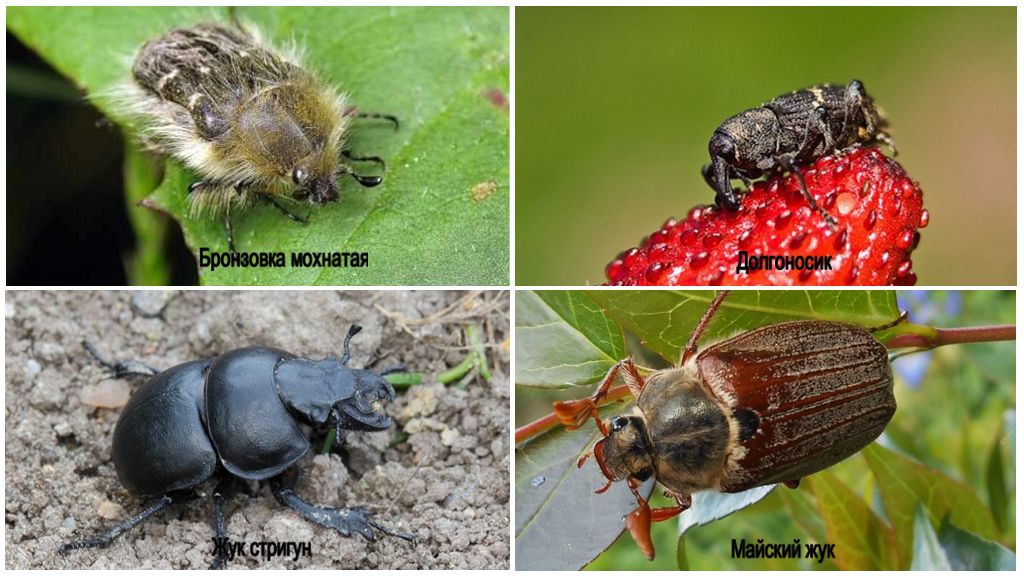
Strigun beetle
Another black bug. Mostly inhabits virgin lands. It got its name for a reason. The insect literally cuts off shoots, leaves that it drags into its burrow, located underground. Easily copes with the vine, so the delicate leaves of strawberries for him - easy prey.
On a note!
Though strigun beetle and omnivorous, but according to the observations of summer residents, prefers cultivated plants to wild herbs.
With a small number of pests, holes are watered with a mixture of water (2 l) and sunflower oil (100 ml). If there are too many beetles, insecticides are introduced into the soil during autumn plowing.
Chafer
Cause harm beetle larvae - Thick, well-fed worms that spend most of their time in the soil. Actively nibble the roots of strawberries, which makes the plants begin to quickly wilt. The stems lose turgor, the leaves turn yellow.
In the spring, aisles are watered with a solution of ammonia: 20 ml per 10 liters of water. Tillage is carried out by means of: Bazudin, Zemlin, Nemabakt, Antichrush.
Strawberry Slugs
Pests are not the most pleasant appearance, popularly called slugs. They look like snails, but lack a durable shell. Parasitize on many vegetable and berry crops. Slime spoils not only leaves, but also eats strawberries. If you take a damaged berry, slippery mucus can be found on it.
On a note!
The molluscs are active in the dark.
To prevent the appearance of slugs on strawberries, a barrier of ash, needles, eggshell, lime, tobacco dust is poured along the perimeter of the plantation. You can also use the drug Metaldehyde, designed to combat slugs on strawberries.
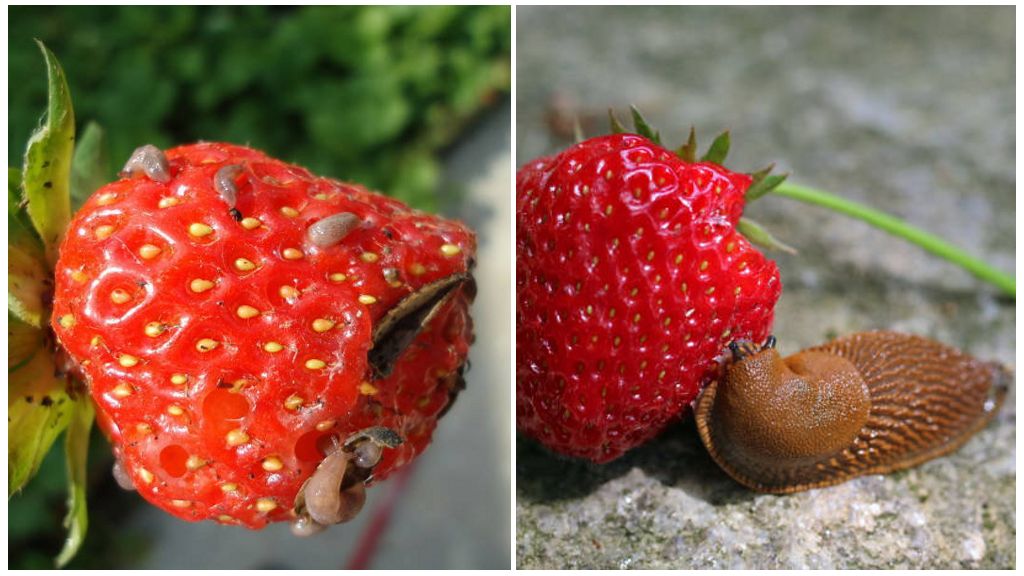
How to process strawberries from pests - folk recipes
Recipes for infusions for processing strawberries:
- Infusion of dandelions. Grind 200 g of freshly picked dandelions or 400 g of green mass. Pour in 10 l of water at room temperature. After 3 hours, strain and add a little soapy solution, which will improve the adhesion of the mixture.
- Garlic infusion is prepared from 0.5 kg of chopped garlic and 5 liters of water. The components are thoroughly mixed, then a soap mixture is added to get 10 l of working solution. It is advisable to use immediately.
- Onion infusion. 50 g of chopped onions or 200 g of husk and 5 liters of water. Insist 15-20 hours, add liquid soap.
- Decoction of tomato, potato tops. Grind 4 kg of potato or tomato leaves in a convenient way. Add 10 liters of water and boil. After 20-30 minutes, remove from heat, cool, pour 2 L of soap solution.
- Soap mixture. Pour 30 g of soap or tar soap into a container with 5 l of water. Insist 5 hours, stirring occasionally, after this time strain.
- Soap-alcohol solution. Add a tablespoon of alcohol to a liter of soap infusion.
- From calendula. 400 g of flowers and 2 l of water insist for at least 4-5 days, then add 3-4 l of water and the working solution for processing strawberries is ready.
- Sagebrush. 200 g of grass and 1 liter of water to brew, cool, mix with 5 liters of water and Art. l liquid soap. Similarly prepared infusion of yarrow, chamomile.
- Tobacco solution is prepared from a pack of cheap cigarettes, which must be freed from paper shells, pour 5 liters of water and leave for 24 hours, then bring to a boil, cool, mix with 1 liter of soap mixture.
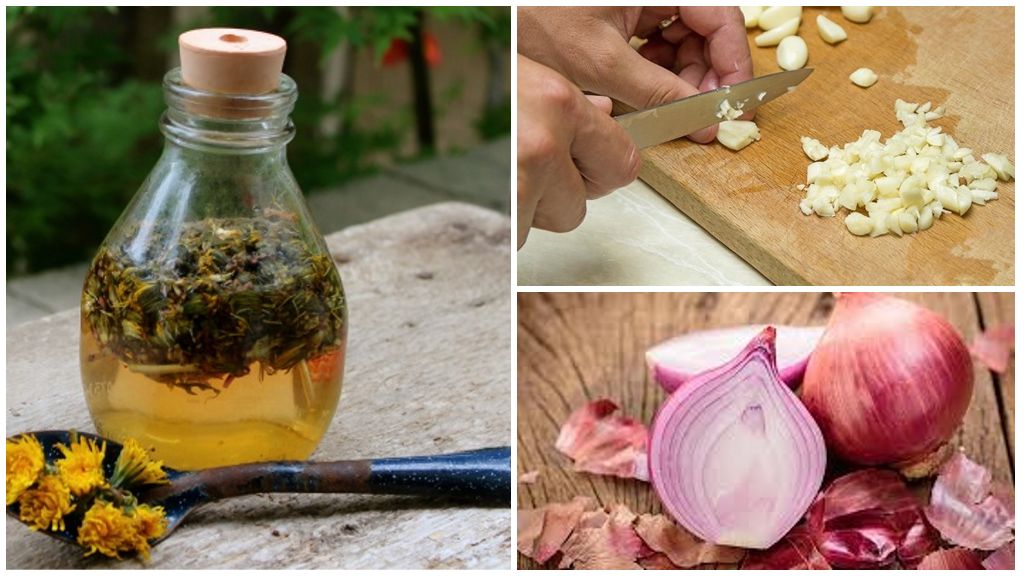
Strawberry disease
The most common diseases of strawberries, there are 7. But even one is enough to lose the fragrant, juicy berries, and even all plantings.
White spotting
She is ramularis. Development begins in mid-May when the weather is wet. Most often, young landings suffer. A whitish coating with a brown border appears on the leaves. Gradually spreads to stems, stepsons, peduncles.
How to fight:
- Sick bushes are eliminated.
- Treatment with Zuparen, Bayleton, Alirin, Bordeaux liquid before each stage of vegetation: leaf formation, flowering, at the end of fruiting.
Brown spotting
Diseases are susceptible to old bushes. The leaves are densely covered with red spots, on which the fungus subsequently takes root. Which leads to the death of the affected fragments.
To treat brown spotting on strawberries, Fitosporin is used.
Gray rot
The appearance of brown, dry to the touch spots located on the stems. The stalk and the berry itself are affected. Outwardly, the spores of gray rot look like wet gray fluff.
On a note!
The development of gray rot contributes to high humidity. Also, spores can be carried by wind from other areas.
The struggle consists in processing Phytosporin, Alirin, ash, vitriol.
Late blight
Late blight develops in the spring, begins with the withering of bushes, peduncles. The core of the bud is damaged, the stamens become black. The set berries are deformed, the tip dries out, the middle is black. The root system is exposed, in a longitudinal section it is red.
Important!
Infected bushes are subject to destruction. Preventive measures: planting healthy material, introducing humus into the soil, mulching, rotation of berry plantations every 4 years.
Leaf rust
In spring, spots of red hues appear on the leaves.On the affected fragments, one can feel the seals. The disease leads to leaf decay, a violation of photosynthesis, the cessation of the formation of rosettes.
Alirin is used for treatment. The debut of deciduous rust contributes to regular shade, meager soil composition, planting strawberries in one area for more than 4 years.
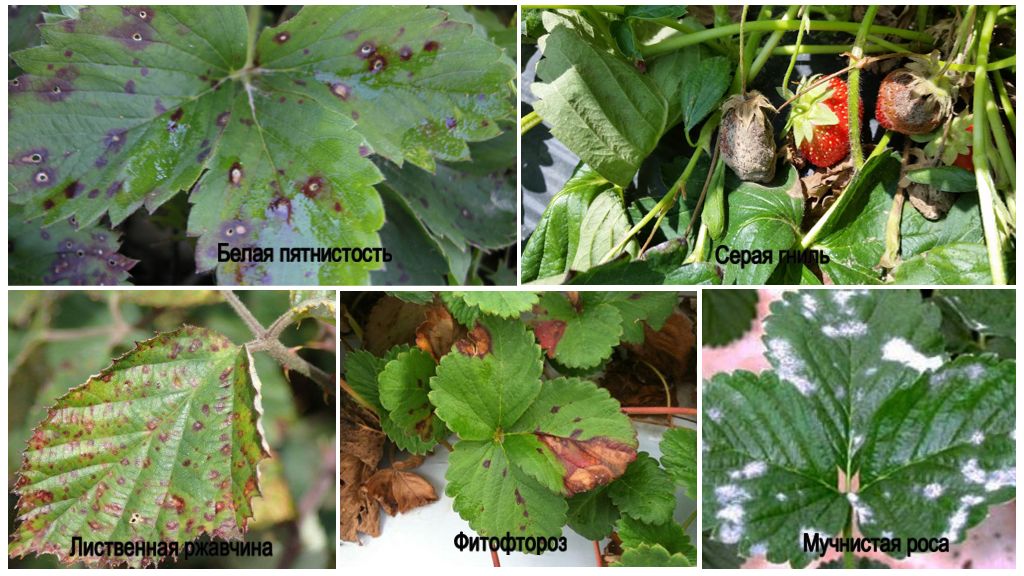
Powdery mildew
A white plaque appears pointwise, which gradually covers all large areas. There is a thickening of the leaves, drying out of the buds and rosettes, darkening of the berries. The disease often affects crowded plantings with concomitant high humidity.
They treat sick strawberries with soda ash, Bactofit, Alirin.
Verticillus wilting
Fungal disease, which manifests itself in slow development, a significant decrease in productivity, the berries become small. Intervein necrosis appears on the leaves. If the fungus progresses to the root system, it gradually turns into a rotten mass.
Important!
In this case, the infected plants are removed and the soil becomes unsuitable for planting new strawberries.
Prevention of pests and diseases
The following measures will help reduce the risk of pest invasion:
- With the beginning of spring, the beds should be cleaned of plant debris, thin out the plants. Pour the soil with hot water with the addition of iodine or manganese.
- Regular cultivation and removal of weeds is an integral measure for the care of strawberries, which allows you to deprive the food supply of pests and destroy individuals in the ground.
- Planting garlic, onions, and calendula near a strawberry will protect against many pests.
- After autumn loosening of the soil, berry bushes need hilling.
- An important stage in the autumn processing of strawberries is pruning, removing old leaves with preservation of protruding stems.
- Fertilizing according to soil composition.
- To process strawberries in autumn with Fitosporin, which will increase the resistance of plants, yield indicators in the future.
